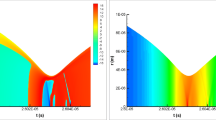Abstract
In the present research, a bubble dynamics based model for cavitating flow simulations is extended to higher void fraction region for wider range of applications. The present bubble model is based on the so-called Rayleigh-Plesset equation that calculates a temporal bubble radius with the surrounding liquid pressure and is considered to be valid in an area below a certain void fraction. The solution algorithm is modified so that the Rayleigh-Plesset equation is no more solved once the bubble radius (or void fraction) reaches at a certain value till the liquid pressure recovers above the vapor pressure in order to overcome this problem. This procedure is expected to stabilize the numerical calculation. The results of simple two-dimensional flow field are presented compared with the existing bubble model.
Similar content being viewed by others
Abbreviations
- c:
-
Coefficient for pseudo- compressibility
- f:
-
Volume fraction
- J:
-
Jacobian
- nG :
-
Number density
- p:
-
Pressure
- r:
-
Radius
- Re:
-
Reynolds number
- t:
-
Time
- T:
-
Surface tension
- u:
-
Velocity
- U:
-
Contravariant velocity
- x:
-
Coordinate
- β:
-
Parameter for added mass
- κ:
-
Specific heat ratio
- μ:
-
Viscosity
- ρ:
-
Density
- σ:
-
Cavitation index
- ω:
-
Vorticity
- ξ:
-
Generalized coordinate
- A:
-
Added mass bub or B— Bubble
- D:
-
Drag
- G:
-
Gas phase
- H:
-
History
- i:
-
x, y, z direction
- I:
-
Inertia
- j:
-
ξ, η, ζ direction
- L:
-
Liquid phase or lift
- P:
-
Acceleration of surrounding fluid
- ν:
-
Vapor
References
KUNZ R. F. et al. A Preconditioned Navier-stokes method for two-phase flows with application to cavitation prediction[J]. Computers and Fluids, 2000, 29: 849–875.
SENOCAK I., SHYY W. A pressure-based method for turbulent cavitating flow computations[J]. Journal of Computational Physics, 2002, 176: 363–383.
DUMONT N. et al. Numerical simulation of cavitating flows in diesel injectors by a homogeneous equilibrium modeling approach[C]. 4th International Symposium on Cavitation. Pasadena, caifornia, USA, 2001.
QIN J. R. et al. Numerical simulation of transient external and internal cavitating flows using the space-time conservation element and solution element method[C]. Asme FEDSM’01. New Orleans, LA, USA, 2001.
REBOUD J. L., DELANNOY Y. Two-phase flow modelling of unsteady cavitation[C]. 2nd International Symposium on Cavitation. Tokyo, Japan, 1994, 39–44.
SHIN B. R., IKOHAGI T. A numerical study of unsteady cavitating flows[C]. 3rd International Symposium on Cavitation. Grenoble, France, 1998, 301–306.
SCHNERR G. H., SAUER J. Physical and numerical modeling of unsteady cavitation dynamics[C]. 4th International Conference on Multiphase Flow. New Orleans, Louisiana, USA, 2001.
TAMURA Y., SUGIYAMA K. and MATSUMOTO Y. Physical modeling and solution algorithm for cavitating flow simulations[C]. 15th Aiaa Computational Fluid Dynamics Conference. Anaheim, CA, USA, 2001, Aiaa 2001–2652.
FUKAYA M., TAMURA Y. and MATSUMOTO Y. Prediction of cavitation intensity and erosion in centrifugal pump based on detailed bubble behavior simulated using bubble flow model[C]. The 11th of International Symposium on Transport Phenomena and Dynamics of Rotating Machinery. Honolulu, Hawaii, USA, 2006.
TAKEMURA F., MATSUMOTO Y. Internal phenomena in bubble motion[B]. Bubble Dynamics and Interface Phenomena, KLUWER, 1994, 467–474.
TAMURA Y., MATSUMOTO Y. Development and validation of a numerical method for cavitating flow simulation[C]. 5th International Conference on Multiphase Flow. Yokohama, Japan, 2004.
KNAPP R. T. et al. Cavitation, engineering societies monographs[M]. McGraw-Hill, 1970, 267–320.
Author information
Authors and Affiliations
Corresponding author
Additional information
Biography: TAMURA Y. (1961-), Male, Ph. D., Professor
Rights and permissions
About this article
Cite this article
Tamura, Y., Matsumoto, Y. Improvement of Bubble Model for Cavitating Flow Simulations. J Hydrodyn 21, 41–46 (2009). https://doi.org/10.1016/S1001-6058(08)60117-1
Received:
Revised:
Published:
Issue Date:
DOI: https://doi.org/10.1016/S1001-6058(08)60117-1




